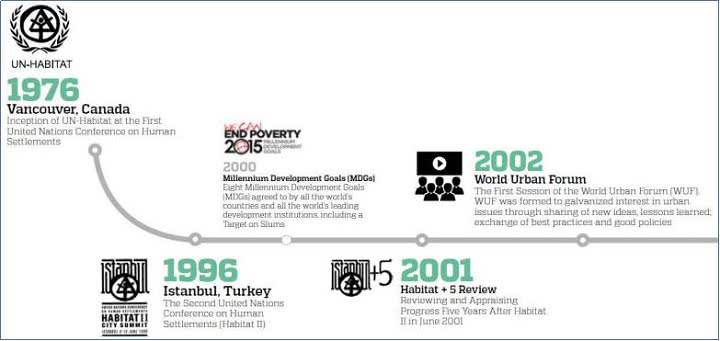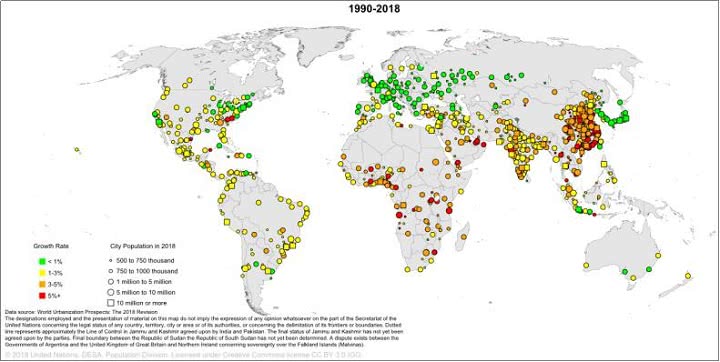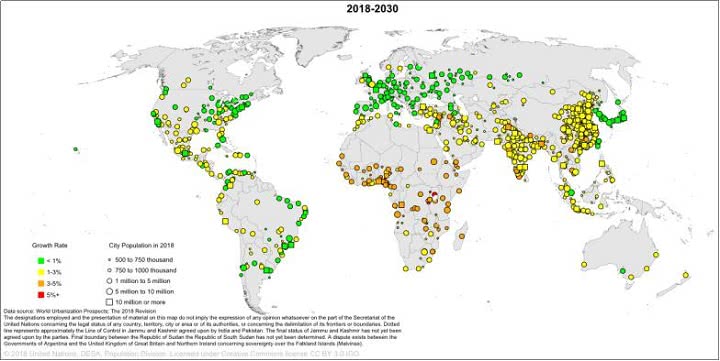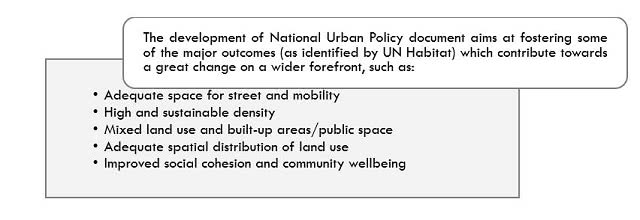The Global Quest of Urbanization
Urbanization is not a new phenomenon. But surely, it took on a whole new dimension in the 20th century. There is a drastic historic transformation of social roots on a global scale. According to WHO, urbanization is the process of global scale changing the social and environmental landscape on every continent. It is a result of population migration from rural areas in addition to natural urban demographic growth. It can be said, with respect to the conventional hypothesis, that no developed country has achieved its level of development or prosperity without urbanizing.
Urban areas currently occupy less than 5% of the world’s landmass, but they inhabit more than 50% of the world’s population. To talk about the impact of it on the environment, the urban areas account for around 70% of the global energy consumption and also the greenhouse gas emission. The way we manage this unprecedented urban growth in the upcoming years can highly influence the consequences on the path of achieving worldwide sustainability. The urban growth will majorly affect the developing nations in the coming times. The correlation between the rate of urbanization and economic growth is weaker in these countries. It implies that the growth of urban areas will result into the creation of slums, illegal squatters, unauthorized settlements etc. This will ultimately bring down the quality of life of people living in these countries.
On the international level, United Nations works for the addressal of such emerging issues through conferences, workshops etc. for formulating policies, frameworks and guidelines. Majorly, the efforts of the organization is to reach the most distant and remote nations. They tend to notice what appears the loudest, yet remains unheard in the contemporary world. The UN Conferences on Habitat occur after every twenty years. These conferences are meant to highlight the key issues that are faced by the majority of people in this world. With time, the focus of the Habitat has drastically shifted to the urban grounds. The urban issues such as infrastructure facilities, transport network, housing situation have attained the focal point. These issues are dealt with a common objective in mind: bringing about social equality, mobility, quality of life, education, global competitiveness, and energy-efficiency.
Habitat I was held in Vancouver in 1976. It was then followed by Habitat II in 1996, which was held in Istanbul. Urbanization always captured the focus of stakeholder. But it was for the first time Habitat III in 2016 that the intricacies of urbanization, its challenges and future prospects were brought into light. It was for the first time that growth rates and the growing city sizes captured the central idea of the whole conference.
Related: Urban Development and Climate Change Relationship
United Nations Conference on Habitat
As stated above, The UN Habitat conferences occur after every twenty years which are meant to highlight the key issues that are faced by the majority of people in this world and further, lay our guidelines to direct the development process. Such precise framework has made it very easy to conceptualize the changing face of the world. Following figure shows the timeline of major events which mark the significance of Urbanization on Global front before UN Habitat III.

Source: World Cities Report 2016, UN-Habitat
Habitat I and Habitat II had a little inclination towards the future prospects of Urbanization, yet they were successful in catering the insurgent needs that rose during that time. Following table highlights the major aspects of Urbanization being identified and addressed during the two conferences:
| HABITAT I, VANCOUVER, 1976 | HABITAT II, ISTANBUL, 1996 | |
| Urban Population | 37.9% | 45.1% |
| Issues Highlighted |
|
|
| Rationale behind the Action Plan | Shelter and Urbanization are global issues and need to be addressed collectively | Urbanization is an opportunity and the strong role of local authorities and public in tapping it must be glorified |
Source: Author
Habitat III
Since the 1996 Habitat II Conference in Istanbul, the world has faced many serious challenges, including rising inequality, increasing insecurity in many places and the widening impacts of climate change everywhere. These challenges earlier had a minimal impact, but later took an uglier face.
The Habitat III conference was held in Quito in 2016; the preparation of which started long back, after the 2nd conference. The formulation and addressal of the global concerns linked to urbanization occupied the central stage. Issues Identified due to increasing urban population in the conference were:
- Increased residency in slums and informal settlements
- Lack of urban facilities and infrastructure
- Insecurity, exclusion and rising inequality
- Pollution, Global Warming and Climate change
For the first time, the term “Global Urbanization” was used; since the world urbanization level increased to 54.5%. Also, apart from the emerging issues, the urban areas contributed around 70% of the total income generated in the world.
Following were the key learnings that were drawn out of the conference:

Further, the conference lead to the formulation of New Urban Agenda, in line with the Sustainable Development Goals. This further coined the significance of formulating the National Urban Policy for managing and directing the growth in the urban sector.
The New Urban Agenda
According to the United Nations Habitat III conference, “The new urban agenda should promote sustainable cities and human settlements that are environmentally sustainable and resilient, socially inclusive, safe and violence-free, economically productive; and better connected to and contributing towards sustained rural transformation.”
The New Urban Agenda focusses at promoting Urbanization at all the levels of the human settlements. It provides a set of guidelines which visualizes Urban Development for next twenty years. There are national priority subjects and standards for sustainable and resilient infrastructure. The development is supposed to spread uniformly across the world, bridging urban, peri-urban and rural extents, and facilitate government in addressing the emerging challenges through national and local policy frameworks. The factor of equity is viewed as an issue of social justice, the public sphere is mandated to become universally accessible, and the opportunities are sought to get diversified.
This is in line with the 2030 Agenda for Sustainable Development (also conceived in the Habitat III conference), especially Goal 11: “to make cities and human settlements inclusive, safe, resilient and sustainable. It ensures access for all to adequate, safe and affordable housing and basic services and upgrades slums”. There are various targets which imply fragmented steps in which the goals are designed. This clearly highlights the efforts of the organization to forge a new framework of urban development.
The Agenda is implemented keeping in mind various physical, social, economic, political implications. The following three aspects are supposed to further get conceived in the development of the National Urban Policy of any nation.


Source: UN World Urbanization Prospects: The 2018 Revision

Source: UN World Urbanization Prospects: The 2018 Revision
National Urban Policy
UN Habitat defines National Urban Policy as “a coherent set of decisions derived through a deliberate government-led process of coordinating and rallying various actors for a common vision and goal that will promote more transformative, productive, inclusive and resilient urban development for the long term.”
The urbanization process is one that is strongly interdisciplinary. To reap positive aspects of urbanization, mitigate its negative externalities, we need a comprehensive approach and clear policy directions. The Urban Policy and planning are supposed to reach beyond the city core. Managing urbanization in a sustainable and equitable manner requires a broader approach to urban planning and policy and a higher level of vertical and horizontal coordination in the form of national-level guidance. This, in turn, implies the need for a coordinated approach and clear policy directions. A National Urban Policy can be considered as a tool that can be used by the government in order to direct and control the process of urbanization. In an ideal situation, with input from the regional and local levels, a coordinated effort from the national level government through a NUP will provide the best opportunity for the development of a coordinating and thorough nation-wide urban development plan. Also, the Policy is meant to foster Urban Development, by simultaneously being resilient to the climate change phenomenon.
Generally, the National Urban Policy is supposed to have four phases: diagnostic, formulation, implementation and monitoring and evaluation. A framework has been developed for the diagnostic phase. The complementary tools for each of the phases are under development. These phases are formulated under the key principles of participation, inclusion, implementable, measurable, affordable (cost-effectiveness and resourceful), pragmatic, action-oriented and people-centered planning processes.

Also Read: Aerotropolis: The New Emerging Urban Form